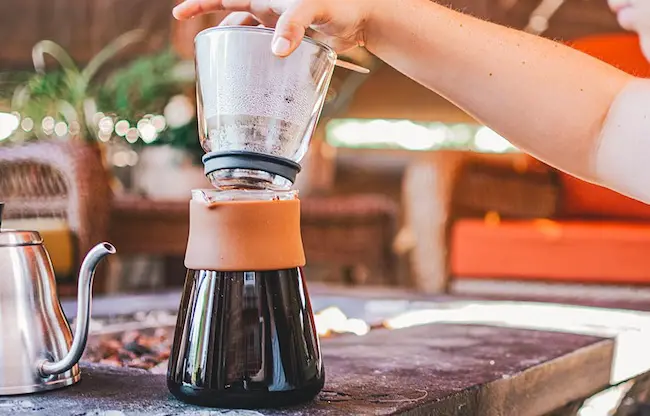Pour over coffee is believed to be one of the best since it gives you the ability to control the speed with which you pour the water over the ground coffee. In fact, many coffee lovers believe it creates a more flavorful cup of brew.
This could be due to the fact that this brewing process is longer than most, allowing for more intricate flavor extraction. The slower the pour, the more time for the water to extract flavor from the grounds, resulting in richer and bolder-tasting coffee.

In this guide, you will learn everything there is to know about using a pour over coffee maker for brewing a cup of delicious coffee.
What is a Pour Over Coffee Maker?
Pour over coffee makers are, simply-put, manually-operated drip coffee machines. With these coffee makers, you’d get a bolder flavor with each brew, thanks to the pour over method.
The pour over method involves pouring hot water through coffee grounds set in a filter. The poured water drains through the coffee and filter into a mug. Pour over coffee makers and drip coffee machines make use of the same process, but there is a huge difference to the brewing mechanism. The pour over method gives you full control over the pouring style, while drip coffee machines do all the hard work.
Things to Consider When Using a Pour Over Coffee Maker
Filter
The filter can produce off-flavors when used, but this can be prevented. There are special filters that cost more, and designed in a way that won’t interfere with the actual flavor of the coffee produced. If you can’t afford that, then you can go with regular filters. Simply rinse with hot water before brewing to wash away any paper residue that could affect the flavor of the grind.
Grind
For the best taste and flavor, ensure that your coffee has a medium-fine grind and only use fresh coffee beans.
Water Quality
Water is the main ingredient in coffee and as such will play a huge role in the flavor and taste of the coffee. Avoid going for unfiltered water since it contains many minerals that could affect your brew. Instead, stick to filtered water.
Water to Coffee Ratio
This could be 21 grams of coffee to 320 grams of water; however, the exact water to coffee ratio should depend on your taste. Go for sensitive scales as they give more accurate ratings, so you won’t end up over-extracting from the coffee beans and obtain a bad brew.
Water Temperature
Another important thing to note when brewing coffee with a pour over coffee maker is the water temperature since it is the key to perfect extraction. The water should be close to the boiling point but never at the boiling point.
How to Use a Pour Over Coffee Maker
Ingredients
- Coffee filter
- Kettle
- Grinder
- Digital scale
- Timer
Instructions
Fill the kettle with 600 grams (20 oz) of water and bring it to a boil.
Grind 30 grams of coffee to fill about 3 tablespoons. The grind should resemble sea salt if you’re going for light roast coffee; you should reduce the amount of coffee used. Go for 23 grams with every 350 grams of water.
Place the filter in the dripper. If you’re using a specialized filter, there is no need to pre-wet it. However, if you’re using a regular filter, wet it with hot water and then dump the water before going ahead to brew.
Add the coffee grounds to the filter and gently tap it till the surface is level. Place the brewer on a cup and then move the entire setup onto a digital set. Set the scale to zero. It would be best to place the brewer on a carafe rather than a cup and then move to the digital scale.
Start a timer and begin to pour the water slowly over the coffee. Start from the outer rim and move in a slow and steady spiral towards the center of the grounds. Watch the scale and stop pouring when it reaches 60 grams. Ensure that all grounds are saturated. You can add a little more water if needed.
The first pour should take about 15 seconds. Wait for about 30 seconds after the first pour to allow the coffee to drip before moving on to the next pour.
In the second pour, start from the center of the grounds. Pour in the same slow and steady spiral towards the outer edge of the filter and then back towards the center. Ensure you reach the edge of the filter as you pour as this keeps grounds from being trapped on the edge and not being extracted.
Stop when the scale reaches 150 grams. The goal here is to keep pouring till all the grounds sink to the surface of the filter. This allows water to extract the grounds easily. Wait for about 1 minute for the coffee to drip before moving to the next pour.
In the pour, you will have to add an additional 100 grams of water. Use the same pattern as the second pour. When the scale reads 250 grams, stop the pour. The entire process should take about 20 seconds.
When the coffee and water from the third pour collects at the bottom of the filter, complete the fourth pour. This will be the final pour and it would add another 100 grams to the scale. You should have a total of 350 grams reading on the scale.
With that done, you can go ahead and take out the cup or carafe and serve.
How to Clean a Pour Over Coffee Maker
Once you’re done brewing, toss the paper filter and the used coffee grounds into the garbage. Wash the brewer with warm water and soap, and dry it. This step is best for glass and ceramic brewers.
If you’re using a stainless steel pour over coffee maker, shake it over the garbage to get rid of any coffee grounds. Then wash it with warm soap and water. Wipe or pluck out any resistant coffee grounds in the filter holes.
FAQs on Pour Over Coffee Makers
Why Does the Coffee Have an Off-Taste?
If the coffee tastes dull or bitter then you might be dealing with a case of over-extraction. This means that the coffee was brewed too much. The solution here is to grind the coffee beans more coarsely so that the draining process won’t take long. You might want to check if your brewer is clean and also check for clogged filter holes.
If the coffee tastes sour, it could be a case of under-extraction and that means you need to brew a little more next time. You can resolve this by grinding the coffee a little finer or pouring the water slowly than before.
Why Isn’t the Coffee Draining?
The reason for this could be that the coffee grounds are too fine and they are fitting nicely into the holes of the filter. To solve this, you would have to wash the brewer and remove any grounds logged into the filter holes. When you’re ready to brew, use a coarser grind setting to prevent this from happening again.







